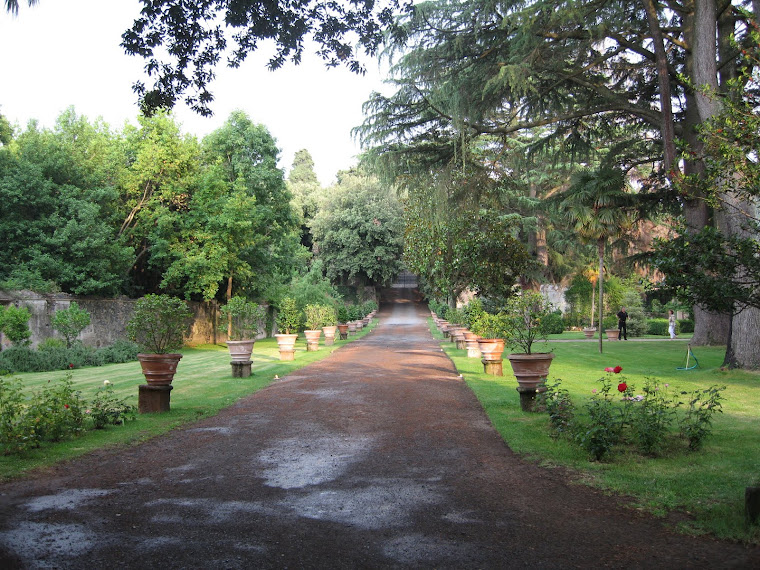
The new museum opened in 2001. Daniel Libeskind built it to add to the existing museum. The new part is a zigzag form. Perhaps it is a broken Star of David? It is open to interpretation. There also are various empty spaces with an obvious interpretation.

We went through the "Axis of Exile" showing the various places where those who were able to flee went to. The area I built on an incline which shows the difficulty getting out.
There were outdoor columns built in an incline do it is unstable to walk there. The area is the Garden of Exile.
The Axis of the Holocaust leads to a tower. As you walk along there is no warning as to what is coming.

The museum covers 2,000 years of history and can't be absorbed in one visit. Our plan was to focus mainly on the modern era including the Holocaust period but my highlights that follow show that we took in quite a bit more.
The Axis of Continuity cuts through the space and leads up to the exhibition. The early portion discusses medieval times and various religious and secular restrictions which regulated how Jews could live. They weren't citizens, had to pay "body taxes" and basically were kept out of things like agriculture and the trades and forced into things like banking.
We can't summarize the exhibition, but one thing of note was the story of Levi's Jeans. Levi Strauss was the youngest son of Rebecca Strauss who emigrated to the US in 1847 with her three youngest children. She left rural Germany where Jews were heavily regulated in terms of what they could do to survive.
Moses Mendelssohn embraced the European Enlightenment and, as mentioned in a post earlier today, introduced secular and modern education into Jewish education. He became a leading figure of the Enlightenment. He also translated the Torah into German. The flip side was to spread German culture among Jews. He wanted Jews to be fully integrated into German life with language as an essential first step. As such he was both an important progressive Jew and an important figure in the German Enlightenment.
(The risks of blogging while walking-I just smashed my toes against a step I wasn't expecting, and I'm wearing sandals.)
Home movies of family life from the '30's by one family looked like home movies I've seen of my own family. The family shown in what I'm viewing moved to Palestine (as it then was) and then to California.
Other parts of the exhibition illustrated the increasing assimilation and secularization of the community such as table ware showing non-observance with dietary laws.

By the mid-19th century certain things remained closed to Jews but some professions became open. Still, popular stereotypes notwithstanding, most lived at or below subsistence despite new opportunities.
Albert Rosenhain founded a leather goods company. "A Rosenhain wallet fits in every pants pocket.". The Nazis liquidated the company in 1938.
One exhibit showed some extensive family trees.
There is an extensive section on 19th century life including racially based (as opposed to religiously based) anti-Semitism and illustrations of the suffering of Jewish Germans who learned that they rather were German Jews, if perceived as German at all. Some converted to open doors and achieve equality, as it seemed impossible to be both German and Jewish. Very few German Jews became Zionists.
Modern Judaism is described in the exhibition as analogous to Protestantism in relation to Catholocism.

The exhibition covers Berlin from 1890-1933 and shows the role of Jewish Germans in modernization of the new German state (founded only in 1871). The KaDeWe department store was depicted. The role played in theatre and other arts also was featured. The works of many Jewish artists working in the area of modern art was criticized as un-German.
For those who wanted a return to pre-modernity, the Jews were blamed for the ills of modernity.
Interestingly Zionists took the view that Jews should go to Palestine to become farmers and leave the roles they'd taken on in Europe. They thought eastern European Jews were more authentic and were critical of German and other western European Jews.
The Jewish role in the liberal movement for social justice in the face of accelerating change was also featured.
Jews fought enthusiastically for Germany in WWI. The post-war Weimar Republic granted Jews full equality. Yet anti-Semitism began to grow as well, with Jews blamed for more and more ills that affected people's lives such as dire economic conditions and the defeat in WWI. The greater the expansion of rights the greater the hostility grew.
When Hitler assumed power in 1933 anti-Semitism became official state policy. There are posters of boycotts against Jewish owned shops. Question: are boycotts of Israeli goods the same or are they more designed to pressure changes in state policy? In any event this marked the end of the movement for equality and the exhibition then explores what came next. Those who were able to leave did so until emigration was prohibited in October 1941.
While the Holocaust is covered the museum really does cover two thousand years of Jewish life in Germany. The last portion of the exhibition covers the post-war period.
We've had another full and exhausting day and will need time and discussion to absorb what we've seen.

No comments:
Post a Comment